Prioritization Scoring Model
Prioritization scoring models play a crucial role in project management and decision-making. By systematically evaluating and ranking options based on predefined criteria, these models help you make informed choices and allocate your team’s resources better.
In this article, we’ll explore:
- What is a prioritization scoring model
- How to use a scoring model
- Different types of prioritization scoring models
- How to calculate project priority
- Benefits they offer
- Steps to implement these scoring models
Let’s dive in and unlock the power of prioritization scoring models!
What Is a Scoring Model in Project Management?
A scoring model helps you evaluate a project’s value in project management. This also means that you cannot spell prioritization scoring models without portfolio management. No matter what model you use, the aim is to maximize the value you deliver through programs, projects, or products.
Value is an operating word before choosing a scoring model. It is a highly subjective term, and you need to align your entire organization with what you mean by that. By assigning weights to each factor and scoring the options accordingly, a scoring model provides a clear understanding of the relative value and priority of different alternatives.
How to Use a Project Scoring Model
Using any project scoring model is pretty straightforward. No matter what type of prioritization scoring model you use (see next section), the preparations should look the same:
1. Define your scoring criteria
The first step is to define your scoring criteria. Not long ago, financial benefits (like ROI) would rule these criteria, but things got a bit more sophisticated.
Most organizations use plenty of quantitative and qualitative criteria to determine the value they get from projects, and we also recommend that, instead of going with a single factor, you use a blend of both worlds.
Either way, your scoring model should have a value criteria and a risk criteria.
Value criteria should include:
- Strategic criteria: how a project measures up to your overall strategic goals.
- Financial criteria: ROI, earnings, net value, etc.
- Business criteria: customer satisfaction, NPS score, etc.
Risk criteria should include at least the following:
- Complexity risk: experts working on the project, expertise available, project requirements.
- Resource risk: internal expertise availability, other resource availability
- Dependency risk: your project’s ties to other projects within your portfolio
Naturally, you can expand on both main criteria. Each peculiar use case will demand different factors and scoring models.
2. Prioritize your criteria
Once you have all your criteria identified, it’s time to compare and contrast them. This will help you determine the weighing of your criteria in your scoring model. Ask stakeholders and decision-makers to perform pairwise comparisons. This is done by plotting two criteria against each other:
| Complexity risk | Equal | Resource risk | |
| Importance | 3 | 2 | 1 |
| Stakeholder | 🔴 |
3. Review your scoring model
After asking each stakeholder, it’s time to review and validate your scoring model. Pit all comparisons in separate tables. This should help you determine the weighting of each criteria defined earlier. In our example, complexity risk is likely to receive a high percentage in the risk main criteria.
| Complexity risk | Equal | Resource risk | |
| Importance | 3 | 2 | 1 |
| Stakeholder 1 | 🔴 | ||
| Stakeholder 2 | 🔴 | ||
| Stakeholder 3 | 🔴 | ||
| Stakeholder 4 | |||
| Stakeholder 5 | 🔴 |
4 Types of Prioritization Scoring Models
Now that we have a solid understanding of prioritization scoring models, let’s explore different types that can be employed in various scenarios.
Different situations call for different approaches, and prioritization scoring models offer a structured way to evaluate options and make informed choices. Let’s take a closer look at some popular models:
1. Weighted Scoring
Weighted scoring is a widely used model that assigns relative weights to different criteria based on their importance. By multiplying the score of each criterion by its weight, this model calculates a weighted score for each option.
Depending on what percentage (or importance) you associate to each criteria, pairwise comparisons will yield a project score. This will help you easily prioritize based on score.
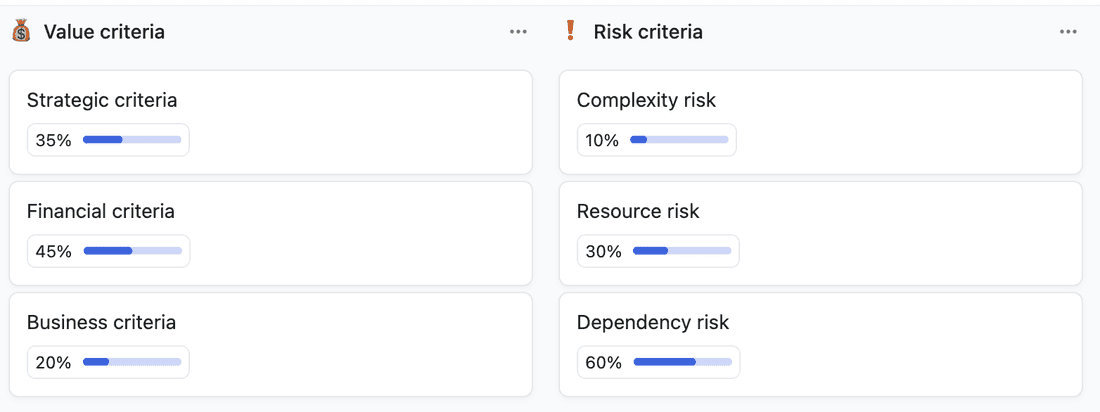
2. Value vs. Complexity Model
Value vs. complexity models are often utilized to prioritize features or requirements. This model considers the value or benefit an option brings to the end user, juxtaposed with its complexity or effort required for implementation. By evaluating the trade-off between value and complexity, teams can make informed decisions that maximize the impact of their software.
When it comes to project management, this highly simplifies your scoring model. Your value and risk criteria are simplified into a 2×2 matrix:
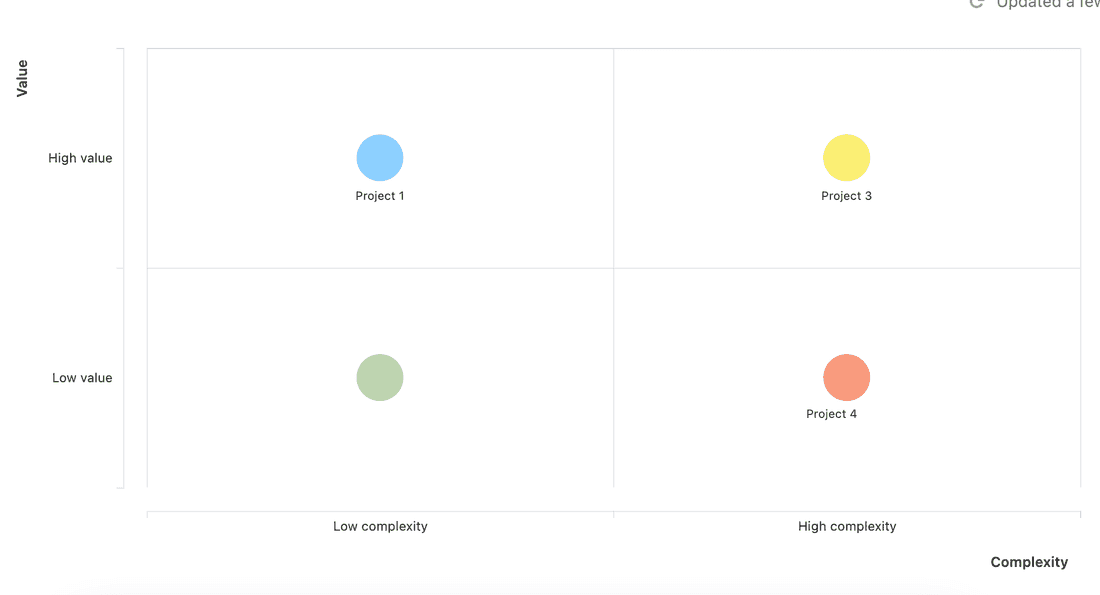
Your upper left quadrant projects will be your highest value-lowest complexity ones. If anything falls here, you should focus your efforts on it. Similarly, avoid the lower right quadrant as much as you can.
Naturally, this model simplifies things a little too much: it hardly lets you differentiate between projects that fall into the same quadrant.
3. Kano Model
The Kano model is named after its creator, Dr. Noriaki Kano, and is commonly used to prioritize projects based on customer satisfaction. This model categorizes projects into 5 distinct categories:
- Must-have: Not having these will result in customer dissatisfaction.
- One-dimensional: These features are directly proportional to customer satisfaction. The more the merrier.
- Reverse: These annoy your customers. Having more of these projects (or products) will result in more dissatisfaction.
- Attractive: Not completing these projects don’t affect your customers. However, having them can be a game-changer.
- Indifferent: There’s hardly any emotion associated with these projects and their outcomes.
The Kano model is great if you want to prioritize customer satisfaction. However, this also means that you naturally need to ignore other factors discussed earlier.
WSJF (Weighted Shortest Job First)
A slightly more scientific approach to prioritization is WSJF. This model requires you to determine the Cost of Delay (CoD) of your projects. If that’s done, the formula is quite simple:
WSJF = Cost of Delay (CoD) / Job Duration
The result of the calculation will help you rank your projects based on the weighted shortest job score.
Its downside? CoD is a highly subjective score. On top of that, this formula will ignore some of your risk criteria and value criteria as well.
How to Calculate Project Priority?
Let’s use an imaginary scenario with 6 projects. First, let’s choose 5 criteria:
- Cost
- Time
- Internal expertise
- Internal workload
- ROI
Next, let’s determine their weight. This is arbitrary in our case, but you might spend more time on this:
- Cost (20%)
- Time (10%)
- Internal expertise (35%)
- Internal workload (20%)
- ROI (15%)
With that settled, it’s time to rank your projects against each other. By using pairwise comparisons and a 1-5 importance chart (it can be 1-3, 1-4, whichever you prefer), you’ll end up with something like this:
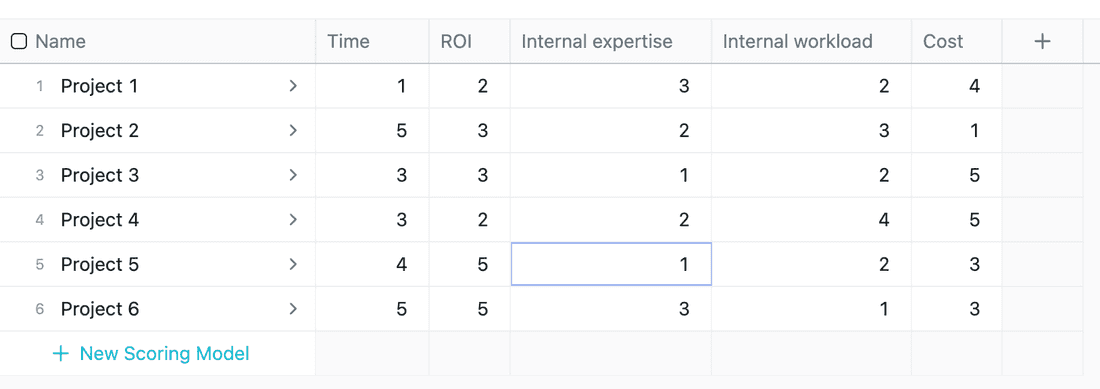
Now, we can apply the previously determined weighted scores on the importance values:

At this point, we only need to add up every value for each project, and sort them to see which is the highest priority:
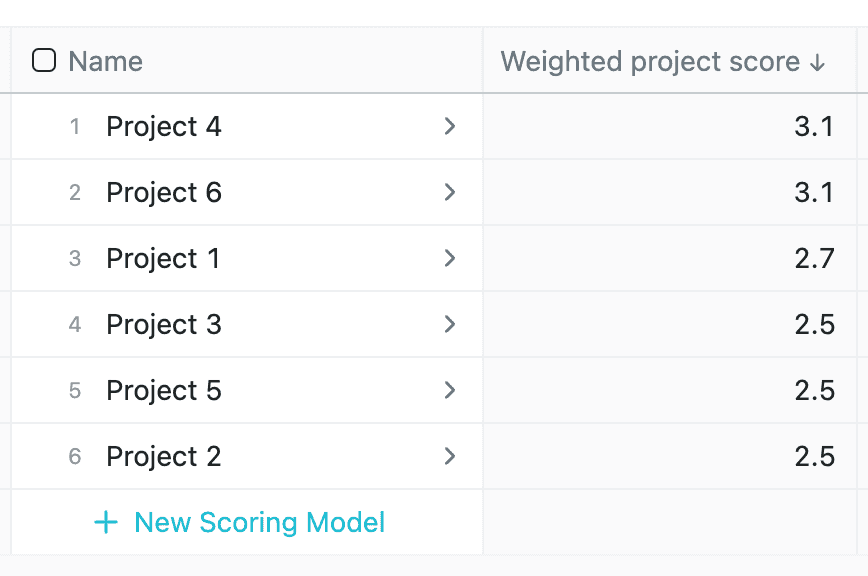
Well, this is a slightly unfortunate situation: our scoring model determined that Projects 4 and 6 are of equal priority. What to do now? One good rule of thumb could be adding a total project sum comparison:
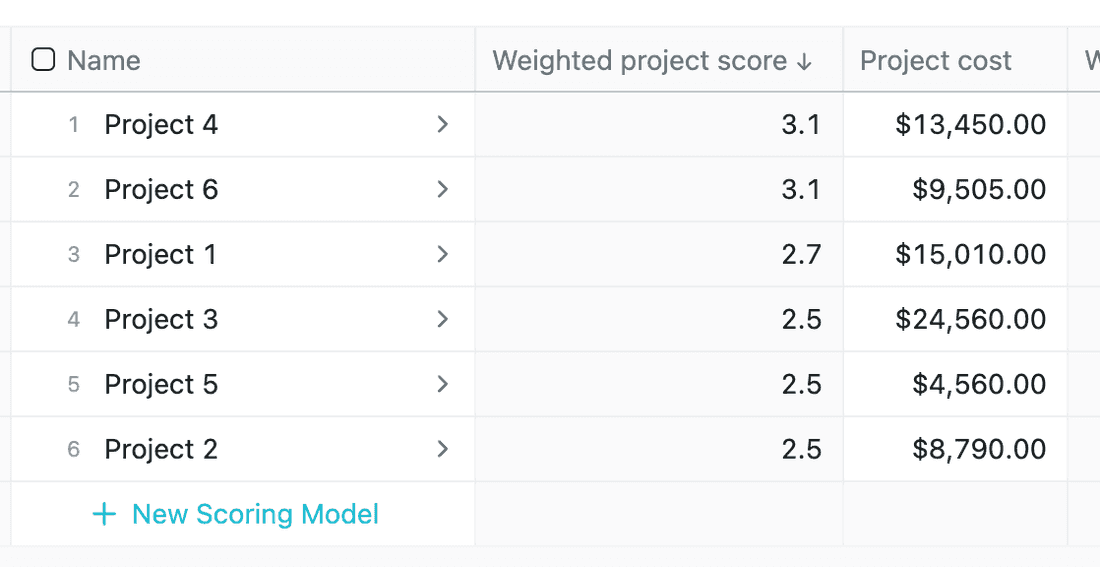
This should help you decide which project to go after. If you are short on funds, it’s probably worth pursuing Project 6, as it costs much less than Project 4.
4 Benefits of Using a Scoring Model
Implementing prioritization scoring models offers numerous benefits that can significantly enhance decision-making and project outcomes. Let’s explore some of the key advantages:
1. Improved Decision Making
Prioritization scoring models provide a structured and objective framework for decision-making. By considering multiple factors and their respective weights, teams can make informed choices that align with their goals and objectives.
This leads to more effective and successful decision-making processes.
2. Better Resource Allocation
Prioritization scoring models enable teams to allocate resources based on the identified priorities. By focusing resources on the options that offer the most value and align with the project objectives, teams can optimize their resource allocation and ensure efficient utilization.
3. Increased Project Success Rate
By utilizing prioritization scoring models, organizations increase their chances of project success. These models help identify and prioritize projects or features that align with customer needs and strategic objectives. By investing time and resources in high-priority options, teams can deliver successful outcomes that meet the expectations of stakeholders.
4. Higher customer satisfaction
By focusing on projects that truly matter, you are more likely to deliver value to your customers. As long as your customer’s point of view is integrated into your scoring model, you can be sure that your projects are not driven by sheer business needs.
In Conclusion
Prioritization scoring models are indispensable tools for effective decision-making and resource allocation. As long as you do the planning part carefully and involve all decision-makers, you will end up with a scoring model that helps you prioritize all your projects with high accuracy.
If you are looking for a template, why not sign up for Fibery? We have highly customizable templates, plus you can build your own process. Yes, even prioritization scoring models.
Psst... Wanna try Fibery? 👀
Infinitely flexible product discovery & development platform.